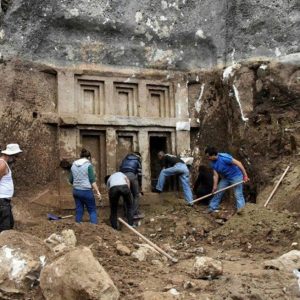A child sacrifice site at the foot of an ancient temple in a lost Aztec city has been unearthed by archaeologists.
The discovery was made at the foot of the ancient Templo Mayor temple, which was found in the heart of the Aztec city of Tenochtitlan.

The young child is believed to have been sacrificed for the Aztec god of war Huitzilopochtli during the late fifteenth century.
Child sacrifice seems to have been a relatively common occurrence in the cultures of ancient south and central America.
Aztecs undertook human sacrifices, including children, as they believed this would bring the rains their crops needed to grow.
Archaeologists unearthed the remains of the young child, believed to have been sacrificed in the late fifteenth century, at the foot of an ancient temple in Mexico, in the ancient Aztec city of Tenochtitlan, which is now the centre of the Mexican capital, Mexico City
The discovery comes 12 years after the location of the first child sacrifice site at the archaeological site, now in the centre of the Mexican capital, Mexico City.
The child’s bones were reportedly found along with body adornments and symbols characteristic of Huitzilopochtli.

The remains, named ‘Offering 176’, were found under the floor of a square to the west of the Templo Mayor, which was the centre of the ancient city.
The young child was believed to have been sacrificed in the late 15th century. The body of the child sacrifice was found hidden beneath stone slabs
The Aztecs had to raise a series of stone slabs from the floor to make way for the body, archaeologists point out.
They then dug a pit in the ground and built a cylindrical box in which the child was placed with volcanic rocks, stuck together with stucco.
One expert told reporters: ‘Then they filled the square with soil brought from the banks of the old lake to build another square on top of it.’

A team made up of the archaeologists Rodolfo Aguilar Tapia, Mary Laidy Hernández Ramírez and Karina López Hernández, together with the physical anthropologist Jacqueline Castro Irineo, had the mission to excavate the find of the Offering 176.
The Aztecs built a cylindrical box in which the child was placed with volcanic rocks, stuck together with stucco. This image shows the remains that were excavated





